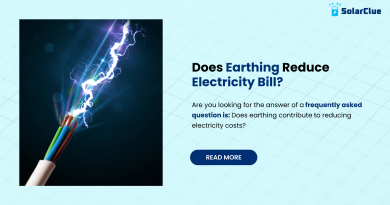How Much Is A Solar Panel System Cost?
Solar energy is rapidly becoming one of the most cost-effective and sustainable energy solutions in India. As the country pushes towards renewable energy adoption, understanding the costs associated with solar panel systems is crucial. This blog provides a detailed overview of the factors influencing solar panel prices, government subsidies, financing options, and market trends in India for 2024.
Table of Contents
- 1 Factors Affecting Solar Panel Prices
- 2 Government Subsidies and Incentives
- 3 Financing Options
- 4 Cost Trends in the Indian Solar Market
- 5 Comparing Solar Energy Costs to Traditional Electricity
- 6 Tips for Getting the Best Price
- 7 The Impact of Panel Size and Wattage on Cost
- 8 Installation Costs and Regional Variations
- 9 Understanding Payback Periods and ROI
- 10 The Future of Solar Panel Costs in India
- 11 Comparison of Solar Panel Types and Costs
- 12 FAQs
Factors Affecting Solar Panel Prices
Several factors contribute to the overall cost of a solar panel system. Understanding these can help you make informed decisions.
1. Panel Type: The type of solar panel you choose significantly impacts the cost. Monocrystalline panels are the most efficient and expensive, followed by polycrystalline panels. Thin-film panels are less efficient but also cheaper.
2. Wattage: Higher wattage panels produce more electricity but also come at a higher cost. The choice of wattage depends on your energy needs and available installation space.
3. Brand: Established brands like Tata Power Solar, Vikram Solar, and Waaree Energies offer high-quality panels at a premium price. While lesser-known brands might be cheaper, they may not offer the same efficiency or durability.
4. Installation Costs: The cost of installation varies depending on the complexity of the setup, roof type, and location. Professional installation ensures safety and efficiency but adds to the overall cost.
5. Permits and Equipment: Local permits, inverters, mounting systems, and wiring are necessary components that add to the total cost. High-quality inverters and durable mounting systems may increase upfront costs but ensure long-term performance.
Government Subsidies and Incentives
The Indian government offers various subsidies and incentives to promote solar energy adoption:
1. Central Government Subsidy: The Ministry of New and Renewable Energy (MNRE) provides a subsidy of up to 40% on rooftop solar systems for residential users for systems up to 3 kW, and 20% for systems between 3 kW and 10 kW.
2. State-Level Incentives: States like Gujarat, Maharashtra, and Tamil Nadu offer additional subsidies and incentives, such as net metering benefits, property tax exemptions, and rebates.
3. Accelerated Depreciation: Businesses can avail of accelerated depreciation on solar panel systems, reducing their taxable income and making solar investments more attractive.
Financing Options
To make solar energy more accessible, various financing options are available:
1. Solar Loans: Financial institutions offer loans specifically for solar panel systems, often at lower interest rates. These loans allow you to spread the cost of the system over several years.
2. Leasing: Under a leasing arrangement, you can rent the solar panels for a fixed monthly fee, avoiding the high upfront costs of purchasing the system outright.
3. Power Purchase Agreements (PPA): With a PPA, a third-party provider installs and maintains the solar panels on your property, and you pay only for the electricity generated at a rate lower than grid electricity.
Cost Trends in the Indian Solar Market
The cost of solar panels in India has been decreasing steadily over the years due to advancements in technology, increased competition, and economies of scale. In 2024, this trend is expected to continue, making solar energy even more affordable.
| Year | Average Cost per Watt (₹) |
|---|---|
| 2018 | ₹50 – ₹55 |
| 2020 | ₹40 – ₹45 |
| 2022 | ₹35 – ₹40 |
| 2024 (Projected) | ₹25 – ₹30 |
Comparing Solar Energy Costs to Traditional Electricity
Solar energy offers long-term savings compared to traditional electricity. While the upfront cost of a solar panel system is higher, the savings on electricity bills can lead to significant financial benefits over time.
| Comparison Factor | Solar Energy | Traditional Electricity |
|---|---|---|
| Cost Over Time | Decreases after payback period | Increases due to fuel and inflation |
| Environmental Impact | Minimal, renewable energy source | High carbon emissions |
| Energy Independence | Reduces reliance on the grid | Dependent on utility companies |
Tips for Getting the Best Price
1. Compare Multiple Quotes: Get quotes from several solar installers to ensure competitive pricing.
2. Leverage Government Subsidies: Maximize savings by fully utilizing available subsidies and incentives.
3. Choose the Right Panel Type: Select a panel type that meets your energy needs and budget. Higher efficiency panels may cost more but provide better long-term savings.
4. Negotiate Installation Costs: Some installers may offer discounts or financing options to lower upfront costs.
5. Consider Long-Term Value: Invest in high-quality components like inverters and mounting systems for better performance and durability.
The Impact of Panel Size and Wattage on Cost
The size and wattage of solar panels directly impact the overall system cost. Larger panels with higher wattage can generate more electricity but are more expensive. However, they may be more cost-effective in the long run, especially for those with higher energy consumption needs.
Installation Costs and Regional Variations
Installation costs in India can vary based on regional factors, including labor costs, availability of skilled installers, and local regulations. Urban areas typically have higher installation costs due to higher labor rates, while rural areas may offer lower costs but may require more logistical planning.
Understanding Payback Periods and ROI
The payback period is the time it takes for the savings on your electricity bills to equal the cost of the solar panel system. ROI (Return on Investment) measures the profitability of your solar investment.
- Example Calculation:
- System Cost: ₹2,50,000
- Annual Savings: ₹35,000
- Payback Period: ₹2,50,000 / ₹35,000 ≈ 7.14 years
- ROI: (₹3,50,000 – ₹2,50,000) / ₹2,50,000 × 100 = 40% over 10 years
The Future of Solar Panel Costs in India
The future of solar panel costs in India looks promising, with prices expected to continue their downward trend. Technological advancements, increased manufacturing efficiency, and supportive government policies are likely to make solar energy even more affordable and accessible in the coming years.
Comparison of Solar Panel Types and Costs
| Panel Type | Wattage Range | Efficiency Range | Cost per Watt (₹) | Ideal Use Case |
|---|---|---|---|---|
| Monocrystalline | 300W – 400W | 18% – 22% | ₹25 – ₹30 | High-efficiency needs |
| Polycrystalline | 250W – 350W | 15% – 18% | ₹20 – ₹25 | Budget-conscious buyers |
| Thin-Film | 150W – 250W | 10% – 12% | ₹15 – ₹20 | Specific applications |
Conclusion
Understanding the costs associated with solar panel systems in India for 2024 involves considering various factors, including panel type, installation, and available subsidies. With solar prices continuing to fall and government support growing, solar energy presents an increasingly viable option for both residential and commercial users. By making informed decisions and taking advantage of available incentives, you can maximize your investment in solar energy and contribute to a more sustainable future.
Here at SolarClue®, we offer a smart, practical, and “beautiful” solution. You will be answered for all the questions related to Solar.
We provide all kinds of brands that are the Best Solar panels in India.
If you are the one who is planning for the solar power system. Don’t hesitate to contact our team!
Looking forward to empowering you with solar energy, just like hundreds of our other clients!
FAQs
1. How much does it cost to install solar panels in India in 2024?
The cost of solar panels in India for 2024 ranges from ₹25 to ₹30 per watt. A typical 5kW system might cost between ₹1,25,000 and ₹1,50,000 before subsidies.
2. What factors influence the cost of solar panels?
Factors include panel type, wattage, brand, installation complexity, and regional labor costs.
3. Are there government subsidies available for solar panel installations?
Yes, the Indian government offers subsidies through the MNRE, covering up to 40% of the cost for small rooftop systems.
4. How long does it take to recoup the investment in solar panels?
The payback period typically ranges from 5 to 8 years, depending on system size, location, and energy consumption.
5. What are the benefits of solar energy compared to traditional electricity?
Solar energy offers lower long-term costs, minimal environmental impact, and increased energy independence.



